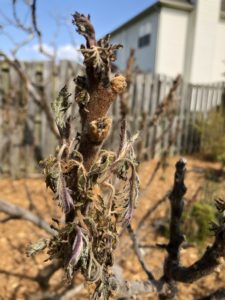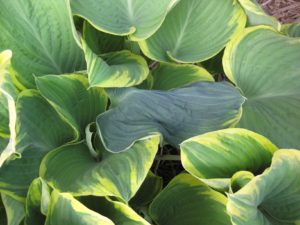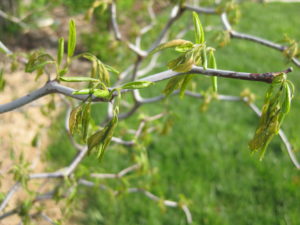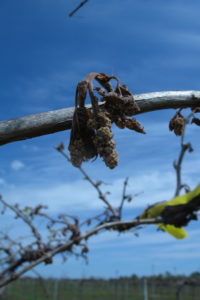A mild winter, followed by a brief warm-up, caused many plants to flower or leaf out before one last freeze. Unfortunately, that succulent new growth is much more susceptible to frost and freeze damage. Freeze injury in many plants will occur when the temperature falls below 32° F (0° C) and the water within the plant’s cells freezes. The ice crystals that develop in the cells puncture the cells, killing them when the tissue warms up, and the cell’s contents leak out. Symptoms of this type of damage include dark green and water-soaked leaves that later turn black as the tissues dies. The speed of this process has a great deal to do with how quickly the plant warms up. With our last two freezes, many people did not see significant damage until the second freeze event when even more susceptible tissue had emerged.
Some plants are better adapted to our challenging Midwest climate. Freeze damage is species and even tissue dependent—some plants will suffer significant damage to their appearance, whereas others are unaffected, or will only lose flowers or fruit. Some of the common landscape plants that are more susceptible to freeze damage include hydrangea, hardy kiwi, porcelain-berry, sumacs, walnuts, Japanese maple, and hosta. Lilacs, viburnums and magnolias will have flowers that turn brown and quickly drop. Other plants will have foliage that appears relatively unscathed, but will lose the developing fruit crop because the flowers were all killed. Homeowners should expect a lighter than usual crop of apples, pears, apricots, peaches, cherries, and plums, and if they have a crop, that the fruit may be russetted, cat-faced, or otherwise damaged from the freeze/frost events. Cane fruit, particularly blackberries, that fruit on old wood, are not expected to have a crop, unless they are primocane varieties that fruit on new wood. Raspberries would be expected to produce a late season crop.
- Fig 1 – Tiger-eye sumac freeze damage. Photo by Janna Beckerman.
- Fig 2 – Frost damage on only leaf of a hosta. Photo by Janna Beckerman.
Grapes were also hit hard, but the possibility of producing a later, albeit lighter crop, remains. With grapes, each bud site possesses a secondary bud that will develop if the primary bud is killed. Although this will keep the plant alive, vines from secondary buds produce fewer fruit clusters resulting in a smaller crop. Thus, the grapes may look bad right now, but the possibility of a crop remains.
- Fig 3 – Frost-killed apricot. Note unaffected leaves. Photo by Janna Beckerman.
- Fig 4 – Freeze damaged grape. Note killed and unaffected leaves and fruit. Photo by Janna Beckerman.
If your plant was damaged earlier this month, don’t worry too much: The prognosis for well-established plants is good, and they will eventually refoliate in the next few weeks. When temperatures warm up, an application of a well-balanced fertilizer will help, but isn’t essential. Most trees, shrubs and perennials can obtain adequate nutrition from their surrounding landscape. Extra care should be taken to minimize the risk of other defoliation events, like those caused by disease or insect for the remainder of the season, but no other special treatment of the plant is needed.
For more information on the effect of cold weather on plants, see: http://www.extension.purdue.edu/extmedia/HO/HO-203.html



